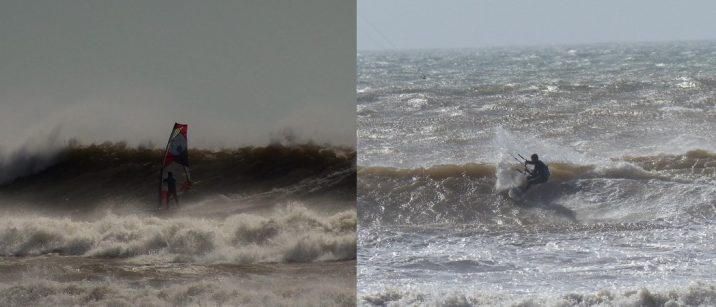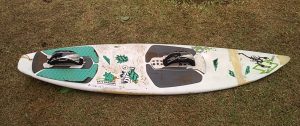Among wind riders, the kitesurfing vs windsurfing faceoff has been going on for years, though kitesurfing has clearly been gaining a lot of ground.
Nevertheless, many people still have a hard time choosing between the two sports since they quite different, with different requisites, learning curves, and riding experiences.
So which of kitesurfing or windsurfing should you go for? Here’s the “short” answer:
WINDSURFING IS FOR YOU IF…
- You’re NOT a patient learner
- You like strength workouts!
- You have at least $2.5K to $3K to spend
- You have a big car and spare storage space at home
- Winds in your area are very light, very strong, or very gusty
- Acrobatics and stunts are not your priority
- You like to hang out with jocks!
KITESURFING IS FOR YOU IF…
- You don’t like bulky gear
- Your budget is around $2000
- You’re healthy but not super fit or athletic
- You have a small car and limited storage space at home
- You’re a disciplined person but can handle a little risk
- You live in an area with moderate and steady winds
- You have access to a large sandy beach
- You know have people to go kitesurfing with
- You like to travel a lot
In the rest of this post, I’ll go through some of the key determinants of whether kitesurfing or windsurfing is best for you.
Table of Contents
1. Kitesurf vs windsurf: what kind of learner are you?
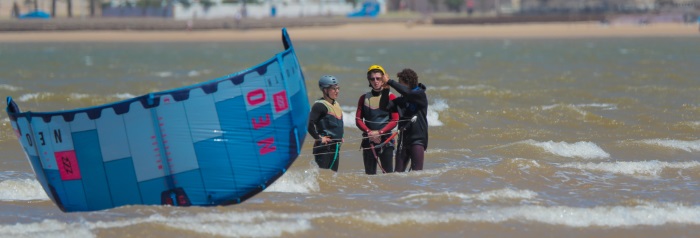
Are you a patient learner? Or do you expect fast results? Kitesurfing has a slower and steeper learning curve compared to windsurfing. In windsurfing, you can start riding after a couple of hours of instruction. However, getting to a level where you can windsurf in all sorts of conditions may take you many months.
Learning to kitesurf to the point you’re independent and can ride upwind generally requires 10+ hours of instruction and a few more of self-practice (see how long does it take to learn kitesurfing). The learning curve is steep and sometimes frustrating as you need to learn flying skills, board skills, and coordination between the two.
Windsurfing learners, on the other hand, are able to get up on the board almost immediately and ride in light to medium breeze after only a couple hours of instruction. With mellow wind conditions, a learner can even self-teach through repeated falling and recovering.
In contrast, kitesurfing instructor lessons are generally required for safety – read can I teach myself to kitesurf. Unlike windsurfing, where you can only learn in the water, flying a kitesurfing kite first needs to be learned on land.
In kitesurfing, once you’ve learned the basics and are able to ride upwind, you’re pretty much set. You’ll be essentially using the same techniques throughout the years – aside from new freestyle tricks and/or wave riding skills.
In windsurfing, on the other hand, sailing on flat water in light wind is only the beginning of your learning journey. You will then need to learn planing at speed, using a harness to unload your arms, using footstraps, and changing direction through tacking or power jibing.
So while you’ll be a proficient kitesurfer as soon as you become comfortable riding upwind, to be an accomplished windsurfer you’ll need to progressively master some tough skills such as doing a waterstart and jibing in strong wind, which takes a lot of time and practice.
Also, aerobatics and wave riding, which most kitesurfers can get into quite easily and naturally after a while, are generally reserved for semi-pros in windsurfing.
So again, if you’re the patient type, you’ll confidently work your way through the 20 hours or so of hard work required to learn kitesurfing and then be done learning. If on the other hand, you want to get riding right away, you can jump onto a windsurf rig and start having fun, but it’ll take you months before you can ride in stronger winds.
2. Kitesurf vs windsurf: how strong and fit are you?
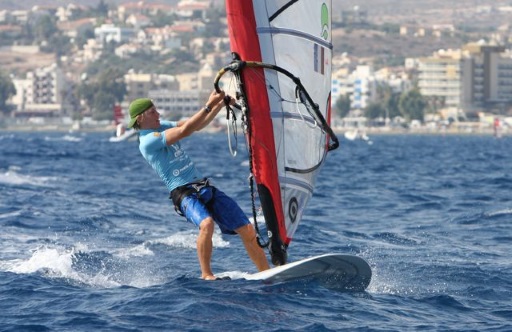
Windsurfing requires a lot more strength, power and agility to reach high levels of proficiency compared to kitesurfing. Kitesurfing can provide a good muscular workout, but it mainly involves core and leg muscles, very little arms.
In windsurfing, a lot of upper body strength is required to sheet in and steer your sail – particularly a large one, and when not using a harness. A lot of arm work is involved, which is why most hardcore windsurfers will have over-developed forearms and biceps. Moving around the board also involves a lot of effort.
Kitesurfing, on the other hand, doesn’t require any arm strength as all the pull from the kite is directed to the harness. You mostly use ab, lower back, glutes, and upper leg muscles. It’s actually quite frequent to see smaller riders or young girls riding with ease and confidence.
Some older windsurfers actually transition to kitesurfing as they age since steering the kite, turning, and even jumping involves much less muscle strength and exertion.
3. Kitesurf vs windsurf: what kind of budget do you have?
Windsurfing requires more gear than kitesurfing and so may cost more money up front. However, you need to take into account how many kite sized you need and how often the kites need replacing. Also, unlike for windsurfing, expensive kitesurfing lessons are generally required.
Windsurfing involves a lot of equipment, including board, sail, mast, boom, mast extension, footstraps, harness, ropes… The cost for these add up quickly, however, entry-level packages can typically be found around $2000-$2500 (new).
In comparison, a new kitesurf kit including kite and bar, kiteboard and harness may be found for $1600-$1700. Kites are more fragile than sails, however, and must often be replaced every 3 years or so (depending on how well you care for it) whereas windsurf gear may last 5-6 year.
Another thing to consider is you generally need 2 or 3 kites to cover a broad enough wind range. You’ll need more windsurfing sails to cover the same range, but sails are generally less expensive than kitesurfing kites.
As you progress in windsurfing, you’ll need to upgrade your gear a couple of times. In contrast, you can generally ride the same kites regardless of your level – although you may want a more specific kite for wave riding or for big air jumping.
For both kitesurfing and windsurfing, you may buy discounted gear from previous years, or used gear. Buying used gear is safer for windsurfing because it’s easier to judge the condition of a sail or a mast by looking at it – whereas a kite may have invisible bladder or valve issues.
And since windsurfing gear is much less fragile, there’s a lot more reliable second-hand gear on the market than kite gear – many used kites and bars (lines) on sale are just about ready for failure.
Overall, including the price of kitesurf lessons, both sports have a roughly comparable startup budget requirement. Over time, however, kitesurfing may end up costing less (assuming good kite care) as new kites and bars will only be needed to make up for wear and tear.
Read more about how much it costs to start kitesurfing.
4. Kitesurf vs windsurf: how much gear can you take home and on the road?
Windsurf gear is a lot bigger and more cumbersome than kitesurfing gear. Windsurfers need a bigger car (van) and much more storage space at home to fit their board, sails, masts, booms… In contrast, a kitesurfer only has a couple of soft backpacks, a 150×43 (max) kiteboard, and a small harness, all of which can generally be stored in a closet.
Even a dedicated kitesurfer with additional gear such as a directional surfboard for waves and a foil board can usually fit all his/her stuff in a small hatchback car and still have room for a passenger.
Kiteboarding gear is also a lot more portable. It’s quite common for kitesurfers to walk to hard-to-access beaches with their kite(s) and board on their back and hands.
I once met a girl who traveled by foot and bus alone across a tropical country. She carried her 5’10 surfboard under one arm, had one small kite in her backpack with her clothes, and another kite rolled up inside her harness which she held in her other hand.
Windsurfers, on the other hand, don’t have the luxury of walking or hitch-hiking to a spot with their gear. When air traveling, they also need to fork out top dollars for excess baggage as they commonly log huge 60+ lb travel bags across the airport.
When I travel for kitesurfing, I can fit 2 kites, 1 or 2 bars, a harness and a wetsuit in a snowboard bag, keeping some clothes in my carry-on pack if necessary. Thus, the only excess baggage I have is my surfboard.
If you travel with a twintip, you can even pack up everything in a kite bag that looks like a golf bag, which some airlines don’t charge for – although this trick doesn’t work as well as it used to.
5. Kitesurf vs windsurf: how much can you cope with?
Kitesurfing is considered riskier than windsurfing due mainly to the long flying range (20+ m kite lines), the low barrier to entry (riders with little experience), the kite’s unpredictable behavior in rough weather, the limited buoyancy of kiteboards, and the high possibility of equipment failure.
When a kitesurfer loses control of his/her kite, the potential damage to other people extends far downwind, on the beach or in the water. The long lines can make things worse as they can cut like a knife or get tied onto something when dragged by a loose kite.
In contrast, windsurfers who lose their gear have a very limited damage range (a few meters). Of course, a windsurfer may get hit my their mast or board, but such accidents generally occur in extreme conditions.
A lot of kitesurf accidents also happen because of sudden changes in weather – e.g. wind picks up or becomes gustier. Inexperienced riders can get overpowered and get dragged upward or outward out of control, or the kite may also go into continuous power loops.
Windsurf sails usually handle strong winds better. Also, windsurfers who ride in rough weather are typically experienced and have the necessary strength to maintain and steer their sail. Many newer kitesurfers will go out in strong winds even though they don’t have the required skills.
Another risk is equipment failure, more likely in kitesurfing. Kite lines snap, kites get ripped, bladders deflate. The impact of such failures is also greater than on a windsurf rig.
When windsurfing, if you get hurt or stuck out at sea, you can usually float on your board and paddle back or wait for rescue. You don’t have that option on a twintip kiteboard, which has no buoyancy when still (directional boards give you a bit more to hold on to).
Finally, jumps and wakestyle tricks on a kite involve significant risk unless you’re very experienced. You can hurt yourself during a bad landing, or hit another rider downwind from you. As a windsurfer, you usually won’t do air tricks until you build up very advanced skills.
In short, if you’re very risk-averse, you should either choose windsurfing or take kitesurfing safety very seriously – monitoring the weather, checking your equipment, choosing appropriate launch/land area, avoiding tricks beyond your skills, getting the right partners.
6. Kitesurf vs windsurf: how is your local wind beach?
Kitesurfing requires a lot of space around you, both on and along the beach, and steady onshore or cross-shore wind preferably in the 12-30 knots. Windsurfers are able to get out in rough, offshore winds, and launch in a tight space or rocky ground without assistance from someone else.
Not everyone has access to an adequate kitesurf spot. Areas with limited beach or rocky zones are not well-suited for kiteboarding. Also, kitesurfers have less precise control over their riding course, so having rocks that stick out from the water can be hazardous.
Very strong and gusty winds, e.g. 40 knots or higher, including with offshore direction, are fine (and fun) for an experienced windsurfer. For a kitesurfer, though, such conditions spell serious danger. Wind range is definitely one of windsurfing’s key advantages.
When kitesurfing, you also want enough space upwind to the nearest hill or building for the wind to smooth out. You need at least 300 feet downwind for safe launching and landing. And ideally, you should have clearance to exit the water far downwind (no cliffs or big rocks).
In contrast, for windsurfing, you need very little space to launch and land. Perturbations due to upwind obstacles is not a problem. You’re also able to sail very high upwind (45º from wind direction vs. about 90º with a kite) so you’re usually able to exit the water wherever you want.
When windsurfing, you do need enough water to keep your fins from hitting the ground or a rock – this can have extreme consequences. Conversely, you can kiteboard on a twintip in as little as 4-5 inches of water.
Finally, you’ll typically need someone’s help to launch and land your kite, particularly in very strong winds. As a windsurfer, you’re pretty much independent.
In summary, the spots you have access to can greatly contribute to determining which of kitesurfing vs windsurfing will be right for you.
7. Kitesurf vs windsurf: what type of riding experience do you seek?
Kitesurfing will give you more of a “hands-free” and open view experience due to the absence of sail in front of you. A windsurf sail, on the other hand, provides a more direct and lively response than a kite, but also a more violent experience when doing tricks.
As a kitesurfer, the control bar is small, has little pressure, and is used mainly for steering the kite. You ride with an open, 360º view which lets you enjoy the world and nature as you glide across the water.
A windsurf rig block half of your view – though sails are partly transparent, and requires active arm work. As a result, some people feel windsurfing doesn’t provide as much of a feeling of freedom when riding.
On the other hand, due to the long lines, steering a kite involves a delay between bar moves and kite response, whereas a windsurf rig responds immediately, making for more aggressive (exciting for some) riding style.
With kiteboarding, jumping and flipping comes much easier (though with some risk), while jumping on a windsurf requires very advanced skills and aggressive maneuvers. Going out through surf and riding waves also involve much less skills in kitesurfing than windsurfing.
8. Kitesurf vs windsurf: what kind of crowd do you enjoy?
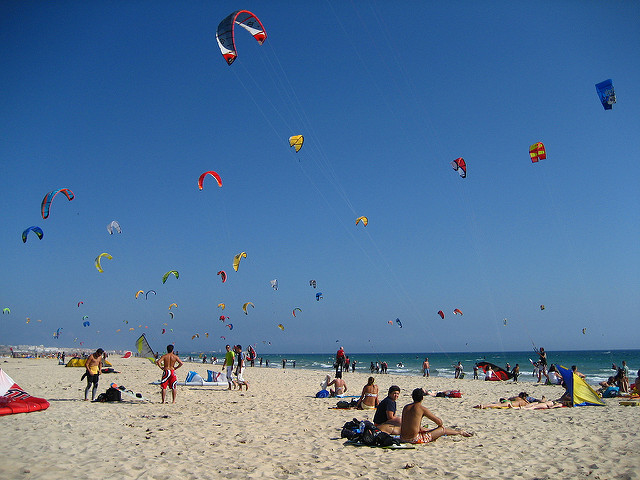
Though both the kitesurfing and windsurfing communities are passionate about their sport, kitesurfing tends to attract men and women of all ages and physical conditions, while windsurfers tend to be athletic males with a strong commitment to the windsurfing lifestyle.
Generally speaking, windsurfers tend to be a close-knit tribe with a common subculture, somewhat similar to surfers. They often hang out among themselves, some with their families, bound by a totalitarian passion for the lifestyle.
Kitesurfers, on the other hand, are a more diverse group which attracts people attracted to the excitement and fun kiteboarding has to offer. Since kitesurfing can be learned in a relatively short time (though with a learning curve), it gathers a very diverse range of people.
Kitesurfers typically don’t have as much of a “tribal” mentality as windsurfers. They may be perceived as more individualistic in a way, but perhaps also more open-minded and welcoming – being accepted in the windsurf community often requires time and dedication.
Conclusion
Kitesurfing has been fashionable for nearly two decades, and that’s for a reason. The fast learning, the lightweight gear, the relatively light fitness requirements, the feeling of freedom, fun and excitement, the relative ease of doing tricks…
In comparison, windsurfing has existed for much longer. Many say it’s here to stay even though kitesurfers increasingly outnumber windsurfers in spots which are suitable for both. Windsurfing is easier to learn and can be practiced in a wider range of conditions.
Like some riders, you may end up choosing to do both sports, opening a world of riding opportunities for yourself, though at the price of a significant gear budget.
[no name]
(CC BY 2.0) by sunshinecity


